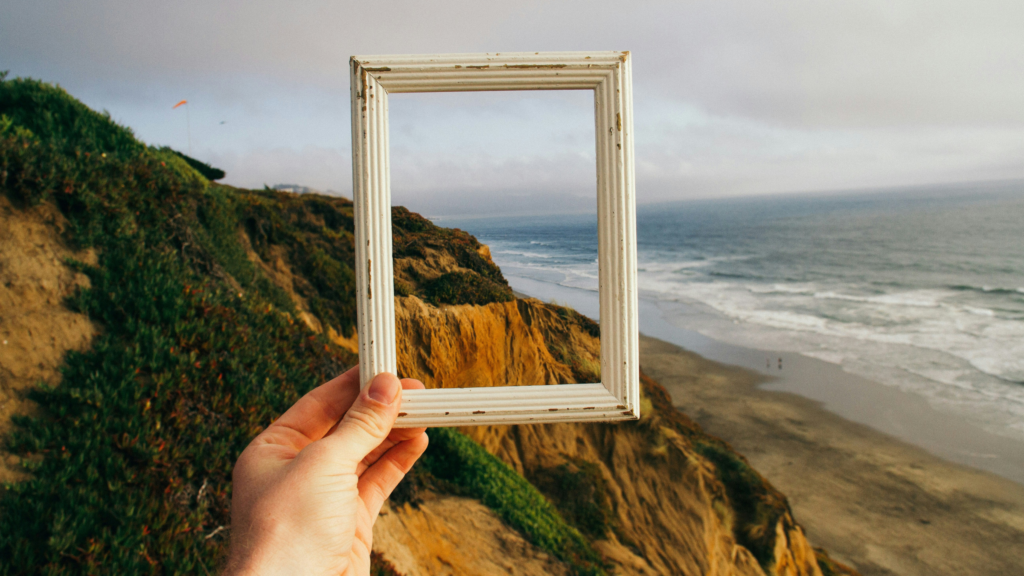“], “filter”: { “nextExceptions”: “img, blockquote, div”, “nextContainsExceptions”: “img, blockquote, a.btn, a.o-button”} }”>
If you’ve ever found yourself stuck in an undesirable mental state, you’re likely aware of the benefits of grounding techniques. Grounding is the act of finding or creating a stable place when you find your thoughts and emotions start to a tailspin. Practices such as mindful movement and meditation can help, while walking barefoot outside can literally ground you to the Earth.
Essentially, grounding gets you out of your head and back into your body. This typically involves combination of self-regulation and interactive regulation—soothing yourself and finding external solace, respectively—to help you return you to a baseline emotional state.
If you’re looking for a creative way to find your center, author and creator Gabi Abrão, known to the Internet as @sighswoon, has an intriguing proposition: Use your imagination to create a felt sense of your desired state. Then, be that.
“I almost think that the actual definition of grounding is giving Spirit some kind of physical phenomenon,” says Abrão, whose art often highlights this notion. She adds that because emotions such as love, worry, and confusion are fundamentally ungrounded, offering these feelings the potential for embodiment can provide an effective outlet.
Take, for example, Abrão’s meme series, titled “Things You Can Pretend to Be When You Feel Uncentered, first posted in 2019. The initial slide features what she calls a “Lush, Self-Sustaining Island,” an image she suggests embodies shifting feelings of loneliness into abundance, honoring independence, and practicing self-care. The island idea came about when, during a bout of heartbreak, Abrão moved her bed into the middle of her living room, repeating, “I am a lush, self-sustaining island.”
“For me it always starts with some seemingly irrational action, but then later I look back and am like, ‘Oh that’s what it was,’” says Abrão of her lighthearted spin on the time-honored practice of visualization. “You can just be like, ‘Okay, yes, I am hurt, I am suffering, I feel alone…let me just be an island.’”
Abrão’s vessels, her term for these imaginings, include a “Giant Smooth Boulder In the Sun Near a Body of Water” for moving from feelings of stagnation to feelings of stability and finding pleasure in simplicity. There’s also a “Castle In the Desert,” conceptualized to increase confidence and resilience while rejecting the need for validation. Since then, the series has grown to include nine “vessels,” the practice expanded on in her book, Notes on Shapeshifting.
If this all sounds a bit silly, Abrão asserts that’s part of the point. “I think that playfulness can get you out of the seriousness of any kind of struggle or moment of being uncentered,” she says. “The goal of every sort of processing is movement, and sometimes this kind of manifestation or playful creation moves you more.”
How To Reimagine Your Emotional Experience
While Abrão’s existing menu of vessels provides a range of possibilities, dreaming up your own image is a worthwhile part of the grounding technique.
1. Start by sitting quietly with yourself. Abrão notes that one of the benefits of the practice is taking some time to actually feel your feelings. Take as much time as you need to identify your emotions—in a meditation, on a walk, during a yoga practice, or wherever and whenever you feel compelled.
2. Imagine either your current or your desired emotional state, and what that would look like to you if it were represented by a person, place, or thing. Remember that your images will be inspired by your own lived experience and will be as unique as you.
“Maybe someone sees an unbridled horse running. Maybe they see a waterfall, like I do. Maybe they see a devoted elderly couple holding hands,” says Abrão, musing over the various responses someone might have to the idea of “passion.” “Really think of what pops into your head, almost like a reverse dream interpretation. You’ll start to realize that your subconscious starts to collaborate with you and you’re not just sitting there illogically manifesting images. They’re already kind of in there and they have been trying to speak to you.”
3. Once you’ve discovered your image, shift your focus to the image and away from your ruminations on self or your current situation. “If you think of that almost cartoonish, playful version of imagination, and then impanting it in your own head, it creates this visceral language that isn’t necessarily logical, but for me, has greater effects,” says Abrão of the grounding technique. “It’s also so fun.”
4. Get curious! Create art inspired by your image, research the elements involved, or read mythology associated with your invented image. Once you’ve found your personal vessels, they’re yours to keep, share (like Abrão), adjust, and to return to as needed.

